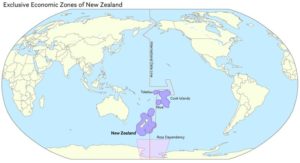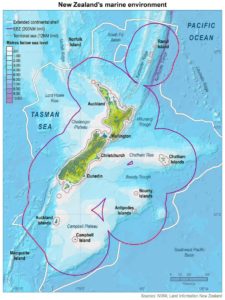Ministry for the Environment: Please explain why our portion of the ocean is not mentioned as a sink in our emissions inventory.
Raised from a comment to a post, this mathematical exposé of our ruling coalition’s wilful blindness to New Zealand’s puny emissions could tickle your fancy, or you may think it cheeky; let me know. – RT
— by Don Graham
“As an avid “man-driven CO2 is going to cook us all” denier, I have explored as a matter of interest New Zealand’s effect on the atmospheric level of CO2 and wrote this article several years back. I emailed it to someone in NIWA and surprisingly did not receive a reply—well, unsurprisingly!
– DG
The problem
New Zealand maintains the right to explore and exploit the seabed and water column within its exclusive economic zone (EEZ) and I cannot see why we should not be allowed to exploit its carbon-sequestering ability, especially since New Zealand is practically unique in having a large EEC and a small population. This is a natural CO2 sink, and we should take economic advantage of it as a CO2 mitigating component.
The maths
The total area of the world’s oceans is approximately 356 million km2 excluding ice-covered ocean (5 million km2). The world produces approximately 7-8 billion tonnes of CO2 annually from fossil fuel consumption and forest burning, etc. Of that we know 3 billion tonnes remains in the atmosphere to accumulate.
The balance of the CO2, 4-5 billion tonnes, goes into the ocean and terrestrial biosphere. It is generally accepted that about 3/4 of this amount, 3.75 billion tonnes, is taken up by the oceans, where for all intents and purposes it remains. Approximately 0.1% is permanently deposited on the bottom and buried in sediments.
The rest revolves in various cycles, some re-emitted at the equator and other warm waters and reabsorbed in cooler waters, but effectively remaining in the ocean.
Not all of the world’s oceans absorb CO2 year-round. A giant swathe of ocean on the equator right around the earth is a net emitter of CO2 so we will subtract it from the total ocean area: 356 million km2 – 41.5 million km2 = 314.5 million km2 of cooler waters.
New Zealand’s annual output of CO2 from burning fossil fuels is around 32 million tonnes and we have about 4 million people contributing to that. Which means that each individual in NZ is responsible for 32 million tonnes ÷ 4 million people = 8 tonnes of CO2 (excluding agriculture).
We know that 3.75 billion tonnes of humanity’s CO2 production goes into the ocean every year and effectively stays there. If we divide that by the area of the cold absorbing oceans (3.75 billion tonnes CO2 ÷ 314.5 million km2) we get 11.92 tonnes of CO2 being absorbed by every square kilometer.
The conclusion
New Zealanders produce 8 tonnes of CO2 per annum each (excluding agriculture). Our cold deep ocean within 200 km of the NZ coastline absorbs 11.92 tonnes of CO2 per sq kilometer per annum and we lay claim to 4.1 million square kilometers of Exclusive Economic Zone which is capable of absorbing 48 million tonnes of CO2 annually.
That is 50% more than we produce!
Effectively our entire national production of carbon dioxide does not make it past our exclusive economic zone! It’s all absorbed by the planet.

The larger oceanic zone of interest within the Realm of New Zealand, including Tokelau, Niue, the Cook Islands and the Ross Dependency, further expands the CO2 sink for our emissions. Nobody could pretend the sink is not there—why is it not accounted for in our emissions inventory?
28 Dec 2018 11:30 am: Don, I tried to contact you but your email address bounced. Would you email me, please, at richard [at] wordshine.co.nz? Thanks.
Views: 747


I wrote a letter in a similar vein to the New Zealand/Northern Advocate (I forget which) several years ago. I didn’t have the maths but with the fifth largest EEZ in the world New Zealand’s marine carbon sink had to be huge and I queried why this was not being included in the “carbon balance sheet”. The letter was published but elicited little response. The logic is hard to dispute. The maths show what a farce this self flagellation that we are currently applying is. This isn’t about climate it is about political dogma
PF: Nice try. It’s nothing to do with climate nor nuffing to do wiv logic.
It’s good to have this perspective – the oceans have absorbed about 30% of anthropogenic CO2, for which we should be grateful (as it buffers global warming) and anxious (lest it stop performing this useful service, and also because of the acidification it causes).
But rather than pose imaginary questions to the Ministry for the Environment, a little googling would answer your question: one search and two clicks brought me to the “UNFCCC reporting guidelines on annual inventories for Parties included in Annex I to the Convention” https://unfccc.int/resource/docs/2013/cop19/eng/10a03.pdf#page=2, where you can see that
“Each Annex I Party should implement and maintain national inventory arrangements for the estimation of anthropogenic GHG emissions by sources and removals by sinks.” [my bold]
Anthropogenic emissions and removals only. Makes sense, really, to only be responsible for the things you can control. Otherwise we’d have to report volcanoes as well.
Well done. You win the prize, MoT. Disagree about the acidification, though; care to quantify what NZ causes? Heard of undetectable?
Remember too that should we ever reduce net global CO2 emissions to zero, the oceans will become net emitters of CO2 until thermal equilibrium is met.
Now there’s a *uckup for the CO2 economists. Well spotted Mister Graham.
that might take 800 years on either count. Your equation is nullified by the absence of a variable called ambient temperature WRT out-gassing. Maybe we soon enter a “Mini Ice Age”. What then would cold oceans emit?
Sadly it is not about any of the above but it is all about saving Marxism and ending Western Civilisation. As Strong, Orestes and Edenhoffer have made clear.
However I must agree that the more we expose them to ridicule and encourage the likes of Simon etc. to help us, the sooner this insanity will be over. Brett, wishing a Happy New Year to All.
Simon wrote:
Mass has to be considered as well. Carbon dioxide has to be transported to and from the liquid/gas interface through both phases. The rate and direction of transfer at the interface will be determined by temperature and Henry’s Law, and the compositions either side of the interface.
We also have thousands of square kilometres of temperate rainforest along with huge quantities of fast-growing manuka and other vegetation. All ignored. The late Owen McShane repeatedly showed that New Zealand overall is a net carbon sink.
All to no avail. The ‘carbon footprint’ of any person, activity or country is a purely political or pop-cultural construct and owes nothing to scientific measurement.
Barry,
Absolutely right. I know I overlook this. It’s increasingly easy to do: a “carbon footprint” is so frequently mentioned beside criticism of one’s “lifestyle” or even merely one’s presumed beliefs that one becomes “gun-shy” and flinches, which induces forgetfulness of science, though science provides the ideal rebuttal.
The strategic purpose of the concept of a carbon footprint is to fabricate a scientific assessment of our influence on the global temperature, and surely our best defence is to mention the absence of science in the concept.
Barry,
Ignored by whom? The national GHG inventory reports removals from our natural forest and several other categories. More than 6 million tonnes CO2 removed in 2016 by “Pre-1990 natural forest remaining pre-1990 natural forest”, apparently: https://emissionstracker.mfe.govt.nz/#NrAMBoE4A4F12ARnAIgHIFMAuL7AEzj6iIBse0qusQA
Exactly, Thessalian.
All carbon sinks that existed before 1990 – therefore all vegetation, EEZ, etc – are excluded from the GHG inventory prepared for the UN. On the other hand, any diminution in those pre-1990 sinks are reported as New Zealand emissions.
Just another example of the fact that the entire UN panoply is driven by politics and negotiations, with zero anchorage in science.
You need a baseline if you are reporting change. The baseline date of 1 January 1990 was defined by the Kyoto Protocol. Think about temperature, reporting is almost always anomalies from a baseline mean.
The baseline of 1990 was fixed by the EU because (a) Western Europe shifted from coal to gas when the North Sea pipelines were opened (1992); and (b) Eastern Europe closed a mass of high-carbon heavy industry and power generation when the Soviet Union collapsed (1991).
The USA (Al Gore) agreed to the 1990 baseline at Kyoto, in exchange for the EU reluctantly agreeing to recognise offsets from Exxon-style carbon-trading. Other Schedule B countries (Japan, Canada & New Zealand) all cut individual deals – eg New Zealand was permitted to use GROSS 1990 emissions while subsequent GHG reporting has been on a NET basis.
It’s all politics.
That’s what happens when you involve politicians 🙂
Kyoto left some scope for individual country negotiation, with the expectation that later agreements would be more onerous. Paris is tougher but even then it will probably not keep temperatures below 2 °C above pre-industrial levels. Most developed countries are not putting policies in place to meet their targets so there will likely be goal blow-out. NZ is running a large risk of having to purchase significant overseas credits to meet their obligations at a unknown future price.
Politicians, yes, Simon. I appreciate the joke. Tough for you marxists that the people will have their way in the end. Your green/communist Party will make its move this year to start destroying our rural economy and way of life just like Stalin did. City folk not realising where their sustenance and overseas funds come from, may support this until it is too late. Though past records show that common sense usually prevails in the bitter end.
One thing I do know is that reason is wasted on pushers of Agenda 21…… Brett
The environment has nothing to do with political leaning. Communist states have historically been among the worst polluters. China has realised that it has to change, especially as environmental degradation is a primary cause of political discontent.
Free markets are the most efficient means of matching supply with demand and the best driver of innovation; providing externalities are accounted for.
Barry,
You appear not to have read my comment, or looked at the link. As I said, NZ’s GHG inventory for 2016 reports more than 6 million tonnes CO2 removed by “Pre-1990 natural forest remaining pre-1990 natural forest”. This is in direct contradiction to your claim. Can you explain how you arrived at that conclusion?